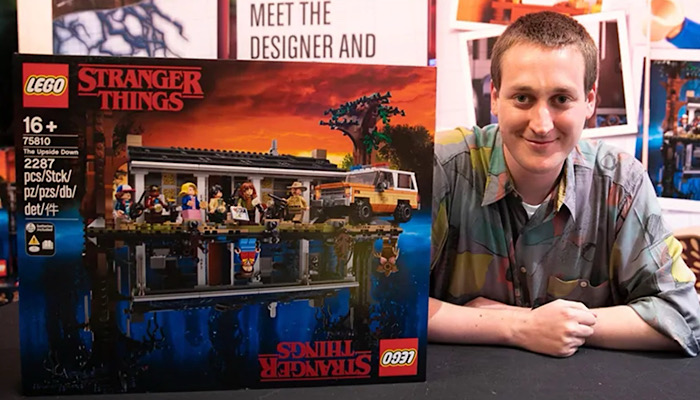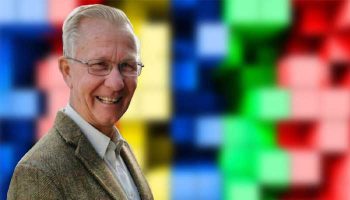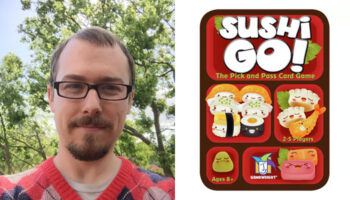LEGO designer Justin Ramsden on giving Stranger Things the brick treatment

“I’ve been a fan of LEGO ever since I was old enough to break my brother’s models,” Justin Ramsden tells us, and now – as a senior designer at LEGO – all that sibling carnage appears to have paid off.
Having been a LEGO designer since 2015 (and been a model builder at LEGOLAND before that), Ramsden has been responsible for a raft of smash-hit sets over the years, spanning brands like Marvel, DC Comics, Harry Potter, The Beatles and The LEGO Movie 2.
His most recent creation has seen him give Netflix’s Stranger Things the LEGO treatment, in the Upside Down set; a properly impressive creation which can be flipped to switch between the real world and The Upside Down.
We caught up with Ramsden to learn more about how he approaches design at LEGO, and what went into bringing the world of Stranger Things to life in bricks.

How did you get your start in toy design? Was there a life before LEGO?
I’ve been a fan of LEGO ever since I was old enough to break my brother’s models. Growing up, LEGO had always been there. In 2004, I went on the LEGO Inside Tour, where you get to take a look behind the scenes and meet LEGO designers. This was the first time I realised you could get paid to play with LEGO! I had never realised ‘LEGO designer’ was an actual job. So while in my early teenage years, that experience cemented what I wanted to do – I wanted to be a LEGO designer.
When I was doing my final major project for my Art Foundation course, I decided to make a bust of Amy Winehouse out of LEGO for a project called ‘British Icons’. That got a lot of media attention, all over the world. That got the attention of the head of model design at LEGOLAND Windsor, Guy Bagley. He invited me to go and interview as a master model builder at LEGOLAND Windsor, so I put my university application on hold and tried my luck. Spoiler alert – I got the job!

So I worked at Windsor for around five years, and got to build models from Minifigure scale to Mini-land scale and even bigger. I got to work on some fantastic stuff, but at the back of my mind, I’d always wanted to be designer of LEGO sets. The dream was to make toys for kids.
I then decided to go back to university and studied design at Goldsmiths University of London. At that point, I thought there might have been more to design than just LEGO, so I managed to get into experience design and I became a project manager for a lot of PR events, making huge edible food installations with food architects.
One evening, I saw a LEGO design job online, so I applied, never thinking I was going to get it, but I did. And four and a half years later, I’m still here as a senior LEGO designer, living the dream.

And you’ve worked on everything from The LEGO Movie sets to Marvel sets to Brickheadz. Is the licensed work what you enjoy doing most?
So my bread and butter is the LEGO Super Hero sets, so working in both the Marvel and DC Comics universes. But I’ve become a lot more curious to work amongst different teams. LEGO has taught me that collaboration is key. From jumping around different teams, I’ve learned lots of new skills and benefitted from collaborating with lots of different people. The Stranger Things set is a good example of this; I got to build upside down – that’s crazy. It keeps everything fresh.
Both IP-based and non-IP stuff have their own challenges. The beauty of working on a Super Hero line is that I get to see the films and read the scripts in advance, and sometimes we have creative liberty to create what we want, be it a bike for this character or a jet for this one – as long as it fits into that comic universe.
When you work on non-IP stuff, you have to pull products out of your own imagination. Sometimes it’s nice to be fed the information, and other times it’s nice to create the universe.
So I imagine you find the constraints on working on a brand actually help fuel your creativity?
Definitely. By having constraints, you learn how far you can push it and how to translate some of the weird and wonderful things into LEGO. Going back to Stranger Things’ The Upside Down – it’s an upside down world and it’s a dark, dilapidated space. It’s an exciting task to transform that into LEGO bricks.
I’m also a huge fan on Stranger Things, and I’ve worked on things like the Batmobile for The LEGO Batman Movie and The Beatles Yellow Submarine LEGO Ideas set – huge licences that I love and have grown up loving. To transform those into LEGO is mind-blowing to me!

What was the first step for you as a LEGO designer when you got the Stranger Things brief?
First steps vary designer to designer. As long as we nail the brief and hit the timings, you can work however you like. Some LEGO designers like to use their computers, others use pen and paper, but I’m old fashioned – I like to pour bricks onto the floor and get building. That’s what the consumer will be doing!

With the Stranger Things set, we started off with a concept sketch. There was an elite team of LEGO designers that joined together to discuss what this model could be. From that meetings, one of the concept designers drew a quick sketch and that became the basis for what the model could look like. We followed the sketch and had a close dialogue with Netflix. There was some back and forth with them, and we did iterations that made the set more stable, more playable and with more functions.
Looking at the Upside Down and the dual nature of that world, I imagine there are lots of different ways you could create that mirror aspect in LEGO.
Yes, and in season one of the show, it almost looks like the Upside Down and the Right Side Up were joined together because people pass through walls. We worked with Netflix really closely to find out how the physics of this universe worked and that was really fun. It’s only at the end of season two where the camera turns upside down that you have a hint that this really is an upside down world. Being a massive fan of the series, it was great to be able to flesh out this world and explore a lot more than what’s on screen.
And LEGO Minifigures have tubes on the bottom of their feet, so they lend themselves to being able to hang upside down, but we’ve attempted a model this size to be so malleable and playable. It’s been fun to figure it all out.

And are there plans for more Stranger Things LEGO sets down the line?
At this point, we’re focussing on this first set. We’ve worked with Netflix previously on their own content and our own content, so it made sense that we celebrate their main show, Stranger Things. Our set champions the series, and that’s why we went all in on this one. As for future projects, I can’t comment!
And is there a brand you’re yet to work with that you think has great LEGO potential?
Well working at LEGO, you have a constant stream of jaw dropping moments. No way are LEGO teaming up with The Beatles! No way are we doing a LEGO Batman movie! So when Stranger Things came around, I was upside down with excitement. I really don’t know what to expect!
So you can’t second-guess it because there’s a strong chance that dream project will be the next one to land in your lap?
Exactly! And I’ve been lucky in that everything I’ve worked on I’ve been a fan of. And if something comes along that I don’t know much about, there’s pleasure in doing all the background research and watching films!
We give everything to making great LEGO models. It’s not just a nine-to-five job. On the drive home, I always think of other great things we could be adding to projects. When I was working on The LEGO Movie 2, I was at home cooking sausages when I realised that I could use sausages for the eyebrows on the Statue of Liberty. These little things just come to you!

And when working on the LEGO Movie 2 sets, did you get to interact much with those working on the film itself?
Yes, we worked really closely with the animation studio. They built the Statue of Liberty for the city of Apocalyseberg (the area they inhabit in the film) and the model they built was eight times the size of what we were working on. I don’t have that much room in my bedroom so we had to make something much more scalable! In the film they use a variety of elements that just aren’t buildable when you get it down to a small scale.
Another thing that keeps the job fresh is finding elements to use in new and exciting ways. A brick separator could become a beak of a bird, or a sausage could become an eyebrow! There’s so many different uses for LEGO elements. I’ve heard people say, “LEGO is too specialised nowadays. Back in my day it was just bricks.” But that, if anything, makes LEGO more creative. You can now take these bricks and use them in new and exciting ways. There’s more opportunities and endless possibilities.
Where do you get you ideas for LEGO sets? Is it a regular thing to find inspiration while cooking sausages!?
It comes from everything. I’m surrounded by 300 of the most talented designers in the world. I work amongst the heroes of the LEGO design world and it’s mind-blowing. Their builds inspire me, and I’ve also worked with concept artists and graphic artists – we’re all in this container of creativity. We also get the opportunity to travel around a lot and get inspiration from the outside world.
I take inspiration from all over the place. I’m a big music fan so going to concerts brings a lot of inspiration, but whether it influences my work, I don’t know! And I also love going to art galleries, just to see what’s out there, and also looking at other toys on the market to see what our competitors are doing.






















